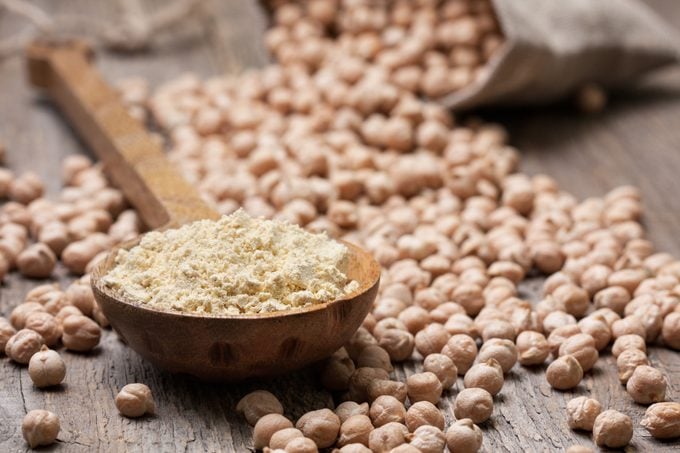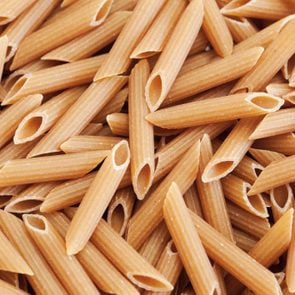How to Make Chickpea Flour and Use It in Everyday Cooking
Updated: Apr. 05, 2021
Making chickpea flour is a lot easier thank you think—and it's more affordable than the store-bought version. Here's a chickpea flour recipe, as well as ideas for how to use this gluten-free flour substitute in everyday cooking.
Are chickpeas the new cauliflower?
If you haven’t noticed, there’s something of a chickpea craze going on right now. We’re talking chickpea muffins, chickpea breads, chickpea tortillas—all made with chickpea flour. (Is chickpea pasta healthy? Learn more)
The beauty of chickpea flour is it’s made from, well, chickpeas, or as they are also called, garbanzo beans. Whatever you call them, these legumes are among the most nutritious foods out there.
No wonder chickpea flour is showing up in so many diet plans—including vegetarian, vegan, keto, low-glycemic, and gluten-free.
Nutritional benefits of chickpea flour
Chickpea flour offers some pretty awesome nutritional perks. Per quarter cup, it contains 89 calories, 5 grams protein, 13 grams carbohydrates, and 2 grams fiber. In comparison, the same amount of enriched all-purpose flour has 114 calories, 3 grams protein, 24 grams carbs, and 1 gram fiber.
You can see that chickpea flour is lower in calories and carbs than traditional flour. “This can help with glycemic control for people with diabetes,” says registered dietitian nutritionist Melissa Altman-Traub, RDN. And it’s higher in protein and fiber—both of which help to keep you satiated longer.
You’ll also get other nutrients from chickpeas, including blood-sugar-helping manganese, folate (especially important for pregnant women), and copper (essential for forming red blood cells).
Why you should make your own chickpea flour
Let’s face it: Many health foods can be pricey. A two-pound bag of chickpea flour ranges anywhere from $3 to $11. The same amount of dried chickpeas—which you can use to make chickpea flour in minutes—is typically just a couple of bucks.
Plus, making chickpea flour from scratch all but eliminates any risk of cross-contamination from wheat or other grains that could introduce gluten into what should be a naturally gluten-free flour. (Gluten is a type of protein found in wheat, barley, and rye, and it can trigger gastrointestinal and other symptoms in people with celiac disease or gluten intolerance.)
“The flour itself is gluten-free, but check the label because some brands are processed in a facility that also processes wheat,” explains Altman-Traub. (See the top plant-based food trends for 2021.)
How to make chickpea flour
“Homemade chickpea flour is easy to make if you have a food processor,” says registered dietitian nutritionist Jen Scheinman. Simply grind raw, dried chickpeas in a food processor or high-powered blender until it develops the consistency of flour. This will take about two minutes. (It’s as simple to make as almond flour.)
Then, use a sieve or a fine-mesh strainer to remove any large pieces or lumps. You can grind those larger pieces in a spice grinder, Scheinman says, so you don’t waste anything. Store your homemade flour in an air-tight container, just as you would regular flour.

An easy chickpea flour recipe
Ingredients:
- 1 pound raw, dried chickpeas
Instructions:
Using a food processor or high-powered blender, process chickpeas for about two minutes, until the chickpeas develop the consistency of flour.
Use a sieve or fine-mesh strainer to remove any large pieces or lumps. Grind any large pieces in a spice grinder.
Place chickpea flour in an air-tight container, and store for up to two months.
How to bake and cook with chickpea flour
Chickpea flour is dense, so when baking you will likely want to sub it in for only some of the original recipe’s flour—anywhere from a quarter to half of the total flour content. If you’re looking to make a gluten-free baked good such as muffins or pancakes, use all-purpose gluten-free flour for the remaining flour. (Take a look at healthy desserts that can help you lose weight.)
“While chickpea flour is traditionally used in Middle Eastern and Indian cuisine, you can also add it to more traditional baked goods in place of other flours,” says Scheinman. “It works best in savory baked goods or those with a strong flavor profile such as cinnamon, nutmeg, or cardamom.”
You can cook with it, too. “Use chickpea flour in place of eggs, similar to how ground flax seeds are used with a mix of flour and water,” suggests Altman-Traub.
As for other savory foods, Scheinman enjoys making socca—basically a large chickpea pancake. “Socca pizza is my favorite way to use chickpea flour,” she says. “When topped with sauce and melted cheese, socca makes for a super yummy pizza.”
Altman-Traub likes to mix chickpea flour with water and spices to create a batter for roasted vegetables. “The vegetables have a crispy exterior without being fried,” she says. Next, check out these other dietitian-recommended pantry staples.



















